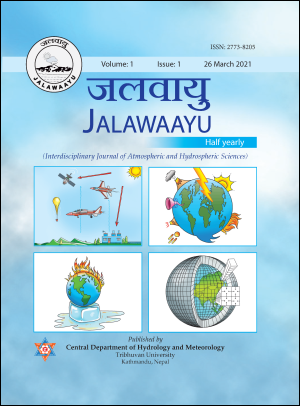Conceptualising Flooding Systems Globally and Preferred Adaptation Strategies Locally under Climate Change
DOI:
https://doi.org/10.3126/jalawaayu.v1i1.36449Keywords:
Flood risk, Scenarios, Community level, Household AdaptationAbstract
Climate induced natural disasters and extreme events are escalating with the increased variability of climatic parameters due to climate change. This study assesses the flood adaptation strategies that are applicable at the community level in two Terai districts of Nepal. This research aimed to analyse existing and preferred future flood adaptation strategies in a flood prone West Rapti River (WRR) Basin of Nepal, and a social survey of 240 households (HHs) and focus group discussions (FGDs). The specific objectives were to identify flood adaptation strategies based on people’s perception. Flood inundation maps are generated for four scenarios based on return periods: Scenario I; Scenario II; Scenario III; and Scenario IV. Peoples’ choice of flood mitigation strategies mainly depends on the current needs of the people and their knowledge of harm. Current needs govern current choices while the basis of future choice is generally made on the degree of the impact or perceived risk of the hazard. This can be clearly seen from the ranking made by the people for Scenarios I and IV. “Household level preparation /management” was ranked first for Scenario I while in Scenario IV “Watershed management” was ranked highest. “Watershed management” was felt to be an important strategy, as it was second ranked even in Scenarios II and III. People may have realised that the mounting flood risk is increasing with time and that such risk can be reduced only through catchment management. When the risk is considered as of low level, people try first to adapt to it at the personal and household level. However, when the risk level increases, people look for alternatives or higher levels of adaptation. The perceptions of people in the study were found to be in agreement with these findings: as the flood risk increases from Scenario I to Scenario IV, the movement in choice of strategies changed accordingly. It can be concluded that when people are well-informed, they will do long term planning and formulate appropriate strategies. This research provides an overall framework for deriving potential mitigation and adaptation strategies to flood for Nepal in particular and other developing countries in general.
Downloads
Downloads
Published
How to Cite
Issue
Section
License
Copyright © of the articles is held by the authors.

